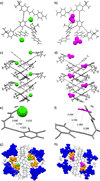Selective nitrate binding in competitive hydrogen bonding solvents: do anion-π interactions facilitate nitrate selectivity?
- PMID: 23939999
- PMCID: PMC3879926
- DOI: 10.1002/anie.201303881
Selective nitrate binding in competitive hydrogen bonding solvents: do anion-π interactions facilitate nitrate selectivity?
Abstract
New tripodal urea receptors demonstrate preferential binding of anions over competitive hydrogen bonding solvents. 1H NMR titrations in 10% DMSO-d6/CDCl3 show a higher affinity for nitrate over the halides for the fluorinated receptor, which is lost when the fluorines are removed. An “anion–π” interaction between the nitrate and the π-system of the ethynyl-substituted arene is proposed as the source of this selectivity.
Keywords: anion recognition; anion-π interactions; host-guest systems; receptors; supramolecular chemistry.
Figures






Similar articles
-
Do CH-Anion and Anion-π Interactions Alter the Mechanism of 2:1 Host-Guest Complexation in Arylethynyl Monourea Anion Receptors?Chemistry. 2017 Mar 23;23(17):4051-4054. doi: 10.1002/chem.201605452. Epub 2017 Mar 6. Chemistry. 2017. PMID: 28198117 Free PMC article.
-
Anion recognition based on halogen bonding: a case study of macrocyclic imidazoliophane receptors.J Mol Model. 2012 Jul;18(7):3311-20. doi: 10.1007/s00894-011-1350-7. Epub 2012 Jan 18. J Mol Model. 2012. PMID: 22252835
-
Anion receptors composed of hydrogen- and halogen-bond donor groups: modulating selectivity with combinations of distinct noncovalent interactions.J Am Chem Soc. 2011 Jul 13;133(27):10559-67. doi: 10.1021/ja202096f. Epub 2011 Jun 13. J Am Chem Soc. 2011. PMID: 21667941
-
Alfred Werner revisited: the coordination chemistry of anions.Acc Chem Res. 2005 Aug;38(8):671-8. doi: 10.1021/ar040071t. Acc Chem Res. 2005. PMID: 16104690 Review.
-
Anion transport with halogen bonds.Top Curr Chem. 2015;358:205-39. doi: 10.1007/128_2014_541. Top Curr Chem. 2015. PMID: 24696354 Review.
Cited by
-
Supramolecular Enhancement of Electrochemical Nitrate Reduction Catalyzed by Cobalt Porphyrin Organic Cages for Ammonia Electrosynthesis in Water.Angew Chem Int Ed Engl. 2023 Aug 28;62(35):e202305719. doi: 10.1002/anie.202305719. Epub 2023 Jul 19. Angew Chem Int Ed Engl. 2023. PMID: 37466386 Free PMC article.
-
[2+3] Amide Cages by Oxidation of [2+3] Imine Cages - Revisiting Molecular Hosts for Highly Efficient Nitrate Binding.Chemistry. 2022 Sep 12;28(51):e202201527. doi: 10.1002/chem.202201527. Epub 2022 Jul 21. Chemistry. 2022. PMID: 35699158 Free PMC article.
-
The road to aryl CHanion binding was paved with good intentions: fundamental studies, host design, and historical perspectives in CH hydrogen bonding.Chem Commun (Camb). 2019 May 8;55(36):5195-5206. doi: 10.1039/c9cc01460h. Epub 2019 Apr 4. Chem Commun (Camb). 2019. PMID: 30944916 Free PMC article.
-
Substituent Effects in CH Hydrogen Bond Interactions: Linear Free Energy Relationships and Influence of Anions.J Am Chem Soc. 2015 Dec 2;137(47):14959-67. doi: 10.1021/jacs.5b08767. Epub 2015 Nov 19. J Am Chem Soc. 2015. PMID: 26539974 Free PMC article.
-
A Synthetic Supramolecular Receptor for the Hydrosulfide Anion.Angew Chem Int Ed Engl. 2016 Sep 12;55(38):11480-4. doi: 10.1002/anie.201605757. Epub 2016 Aug 11. Angew Chem Int Ed Engl. 2016. PMID: 27510286 Free PMC article.
References
-
- Işiklan M, Saeed MA, Pramanik A, Wong BM, Fronczek FR, Hossain MA. Cryst. Growth Des. 2011;11:959–963. - PMC - PubMed
- Brooks SJ, Gale PA, Light ME. Chem. Commun. 2006:4344–4346. - PubMed
- Santacroce PV, Okunola OA, Zavalij PY, Davis JT. Chem. Commun. 2006:3246–3248. - PubMed
- Tongraung P, Chantarasiri N, Tuntulani T. Tetrahedron Lett. 2003;44:29–32.
- Herges H, Dikmans A, Jana U, Köhler F, Jones PG, Dix I, Fricke T, König B. Eur. J. Org. Chem. 2002:3004–3014.
- Hettche F, Beiss P, Hoffmann RW. Chem. Eur. J. 2002;8:4946–4956. - PubMed
- Bisson AP, Lynch VM, Monahan M-KC, Anslyn EV. Angew. Chem. 1997;109:2435–2437.
- Angew. Chem. Int. Ed. Engl. 1997;36:2340–2342.
-
- Makuc D, Albrecht M, Plavec J, Rissanen K, Valkonen A, Schalley CA. Eur. J. Org. Chem. 2009:4854–4866.
- Sessler JL, An D, Cho W-S, Lynch V, Marquez M. Chem. Eur. J. 2005;11:2001–2011. - PubMed
- Burns DH, Calderon-Kawasaki K, Kularatne S. J. Org. Chem. 2005;70:2803–2807. - PubMed
- Clare JP, Ayling AJ, Joos J-B, Sisson AL, Magro G, Pérez-Payán MN, Lambert TN, Shukla R, Smith BD, Davis AP. J. Am. Chem. Soc. 2005;127:10739–10746. - PubMed
-
- Hudeček O, Budka J, Dvořáková H, Cuřínová P, Císařová I, Lhoták P. New J. Chem. 2013;37:220–227.
- Young PG, Jolliffe KA. Org. Biomol. Chem. 2012;10:2664–2672. - PubMed
- Juwarker H, Lenhardt JM, Castillo JC, Zhao E, Krishnamurthy S, Jamiolkowski RM, Kim K-H, Craig SL. J. Org. Chem. 2009;74:8924–8934. - PubMed
- Byrne P, Turner DR, Lloyd GO, Clarke N, Steed JW. Cryst. Growth Des. 2008;8:3335–3344.
- Chang K-J, Moon D, Lah MS, Jeong K-S. Angew. Chem. 2005;117:8140–8143.
- Angew. Chem. Int. Ed. 2005;44:7926–7929. - PubMed
-
- Dawson RE, Hennig A, Weimann DP, Emery D, Ravikumar V, Montenegro J, Takeuchi T, Gabutti S, Mayor M, Mareda J, Schalley CA, Matile S. Nat. Chem. 2010;2:533–538. - PubMed
Publication types
MeSH terms
Substances
Grants and funding
LinkOut - more resources
Full Text Sources
Other Literature Sources
Research Materials
Miscellaneous

